
🔒⚡ UR Remains Sub-53% In March As Uber Officially Launches NYC Lockouts. What's Going On?
Year-to-date (YTD) URs remains below 53% as Uber officially launches NYC driver "lockouts". UR needs to be abandoned as a regulatory metric and "supply" needs to be empowered again. We explain.
Industrywide utilization rate (UR) is a key metric used in NYC TLC’s driver minimum pay calculation for high-volume bases (currently Uber and Lyft)
UR is how busy a driver is kept while logged into either Uber or Lyft in NYC
March industrywide UR increased to 53.4%, but year-to-date UR still remains at 51.0%, well below 53.0% TLC regulatory floor
Uber officially launched NYC driver lockouts today
OPINION: UR needs to be dropped and "supply" needs to be empowered again
This is our eighth monthly update on NYC TLC utilization rates (UR). UR can simply be described as how busy an Uber / Lyft NYC driver is kept while they are logged into an app.
Recently, we reported on Uber’s warning to its NYC TLC driver base that the company might need to make changes to a driver’s “ability to go online in certain areas and during certain times of day.” This dynamic is often referred to as driver “lockouts” in the industry and was last seen in pre-pandemic NYC. Today, Uber made good on its warning and officially (re)launched NYC driver lockouts.
March 2024 UR Figures
Since there is no like-for-like March 2023 benchmark, we think it’s best to summarize the latest TLC Factbook data as follows:
⚫ Uber UR was 54.8% in March 2024. While this is an increase vs. last month, Uber’s YTD standalone UR of 52.5% is still below the 53.0% UR regulatory floor
🟣 Lyft UR was to 49.9% in March 2024. While this is an increase vs. last month, Lyft’s YTD standalone UR of 47.0% is still well below the 53.0% UR TLC floor
📉 Industrywide UR was 53.4% in March 2024
📉 Industrywide UR is 51.0% Year-to-Date (YTD) to March 2024, still well below 53% UR floor baked into the NYC TLC minimum driver pay formula
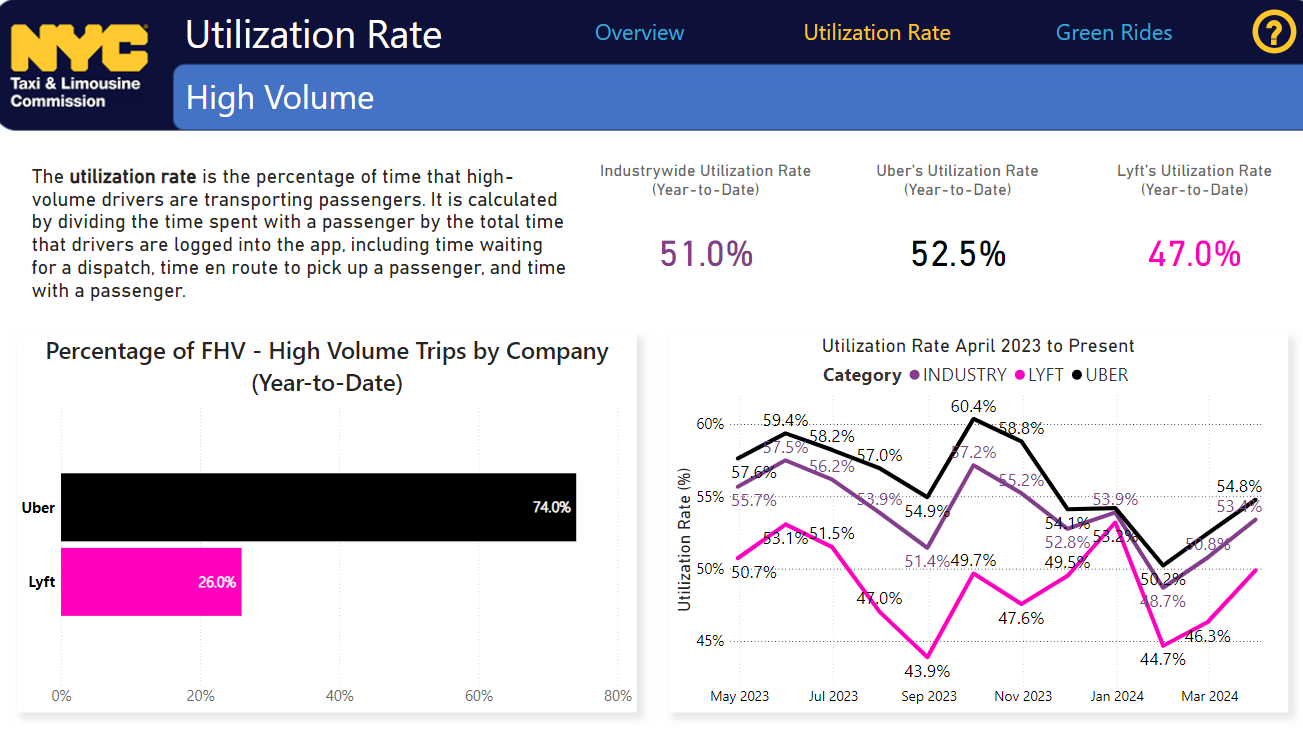
Remember, industrywide UR is measured on a calendar year (January to December) basis, so there might be some months that can drag the average lower, but are offset by other months that are busier. A 😟 51.0% industrywide UR three months into 2024 UR data, still seems dangerously below the 53% UR floor included in the TLC’s minimum driver pay formula.
A sub-53% calendar year industrywide UR would be disastrous for both Uber and Lyft NYC operations. To be simple, the amount the apps would have to pay drivers would increase, but at the cost of less drivers being able to freely log into the apps.
The decision of Uber (and effectively Lyft) in NYC to restart driver “lockouts”, or restrict the ability for active TLC drivers to access their driver apps 24/7, is not surprising to us given the above UR data and the addition of over 10,000 *new* FHV Licenses (TLC Plates) in 2023. If seasonal UR trends are similar to last year, July and August 2024 will likely drag industrywide UR lower, after it peaks in June (unless driver lockouts change summer industrywide UR results).
Article continues after advertisement
Lyft At Fault?
As per the company’s s previous email communication and today’s messaging, Uber appears to be primarily blaming low industrywide UR on smaller, longtime archrival Lyft. Firstly, Uber’s standalone YTD UR is still below the 53% regulatory floor after three months, so there’s that. Neither Uber or Lyft are crushing NYC UR metrics, it’s more a one company is doing less worse than the other, situation.
Uber’s lobbying to be judged on a standalone basis would likely result in Lyft effectively going bust in NYC or losing a lot of market share. If you’re interested in our logic on why that would happen please refer to this recent article.
Who’s At Fault?
As we’ve previously stated, UR as a regulatory metric should be dropped altogether. For-hire vehicle supply caps and even limiting the issuance of commercial TLC driver licenses, should be prioritized. These are more “first principle” ideas and ways to protect driver pay and balance marketplace supply & demand. In addition, these methods are easier to understand, measure and implement.
The TLC’s UR metric was created with the noble 😇 goal of making sure Uber and Lyft paid commercially licensed NYC TLC drivers fairly. For example, a driver is paid a gross wage rate of $30 per hour for the 20 minutes they are online and driving for Uber, but that driver isn’t earning anything for the 40 minutes they are idle (waiting for their next trip). Clearly, that driver is not earning $30 per hour. They are effectively earning less than New York State mandated minimum wage.
$30 per hour * (20 mins / 60 mins) + $0 * (40 mins / 60 mins) = $10 per hour (gross)
UR feels like an intelligent metric that a very smart person, or group of smart people, spent a lot of time formulating in a university setting 🤓. However, it’s not working. Firstly, it only applies to Uber and Lyft in NYC, the other sectors of the NYC for-hire transportation industry are not subject to it. The TLC has created different sets of rules for one industry. For example, we all understand the yellow cab industry protects driver wages via a very strict cap on for-hire vehicle supply, the origin of the taxi medallion system. To create several, fundamentally different regulatory regimes to govern one industry, is a recipe for disaster.
Do people think New Yorkers in the 1930s didn’t face the same issues we face today? Issues like protecting wages or there being too many cars on City streets. Just because someone came up with a complex formula, that very few people understand, doesn’t mean it’s a better idea than what a group of thoughtful 1930s public servants already came up with 85+ years ago. In addition, the 85+ year old idea is still, to this day, easily explained and understood by many people (this is critical).
We’re also not saying no rules should or can be updated to reflect modern realities. However, and this objectively observable, the system those New Yorkers came up with in 1937, lasted long after most of them died. The new TLC rules that include (not limited to) a UR-based pay formula, weakly enforced for-hire vehicle supply cap and an EV mandate, hasn’t stood the test of a few years.
With the shock release of 10,000 FHV Licenses (TLC Plates) in 2023 alone, the City and TLC are not even following the FHV License Pause they correctly created in the summer of 2018. Limiting the issuance of TLC Plates was fundamentally created to protect driver wages! 🤔
More broadly, the attraction and promise of Uber and Lyft across the world is, and has always been, work when you want, where you want. In addition, use something you need and own anyway, your car, to earn additional income (more applicable pitch outside of NYC). When there is an “anyone can join when they want” driver supply dynamic, the government often incorrectly approaches the problem as follows:
100,000 drivers should earn $30 per hour
110,000 drivers should earn $30 per hour
120,000 drivers should earn $30 per hour
130,000 drivers should earn $30 per hour
140,000 drivers should earn $30 per hour
180,000 drivers should earn $30 per hour
250,000 drivers should earn $30 per hour
500,000 drivers should earn $30 per hour
Is there enough demand and money to go around that makes this possible? Clearly, to just view driver pay without contextualizing how supply might impact that pay is…not intelligent (respectfully).
Uber and Lyft are not social welfare institutions that are under obligation to pay infinity ♾️ drivers, $30 per hour. These are for-profit businesses. They generate “demand”, the passenger is their customer. The driver is less their customer, more their “partner” helping them provide services to their customers.
With the UR-based driver pay formula the TLC has unintentionally given Uber and Lyft more power to deepen their duopoly grip of the NYC TLC market and hold drivers hostage. As soon as a new entrant passes the 10,000 trip per day (“high-volume” base) threshold, that company is out of business as it can’t achieve 53% standalone UR when two companies control ~80% of the market. This is why we think Revel’s trip stats disappeared just as they were approaching high-volume for-hire service (HVFHS) license thresholds.
“The demand” controls all the power in a world of UR. However, “the supply” accrues value when its harder to disintermediate drivers. Vehicle supply caps (remember 70%+ of drivers control their own TLC plate) and perhaps TLC driver license issuance control mechanisms (i.e., make exam harder) gives drivers true power, not UR. For example, before Uber kicks a TLC driver off its platform they will need to think twice because the driver is 1 of X vs. 1 of ♾️.
We think our discussion with user Optimus spells out the point we are trying to make.
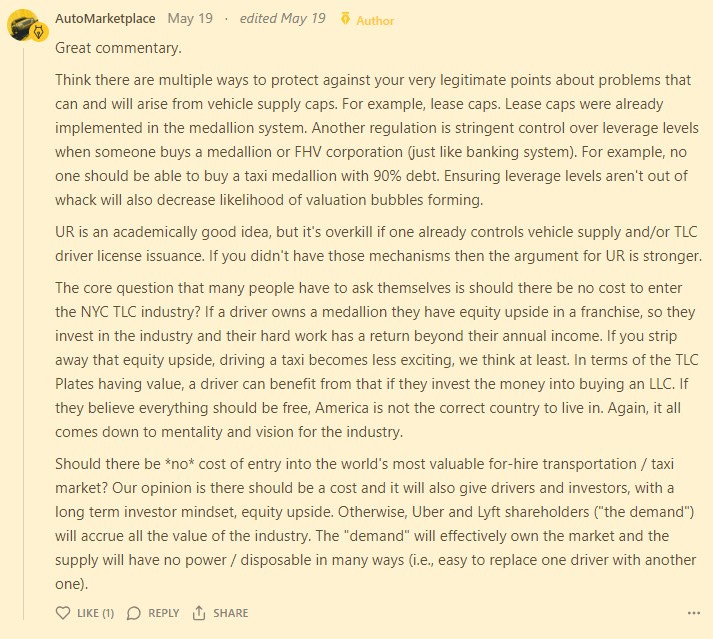
As a very brief side note, we believe collapsing demand and supply marketplace dynamics will be the next iteration of the “rideshare app”, especially as we enter a world of robotaxis. To be simple, drivers and riders own the app. Where people get this wrong, in our view, is they envision a driver-only owned app vs. a driver and passenger-owned app (the demand and supply). This is a focus of AutoMarketplace’s future business plans (stay tuned 📺). However, until any new marketplace paradigm is established, it’s time for “the supply” to gain power back from “the demand”.






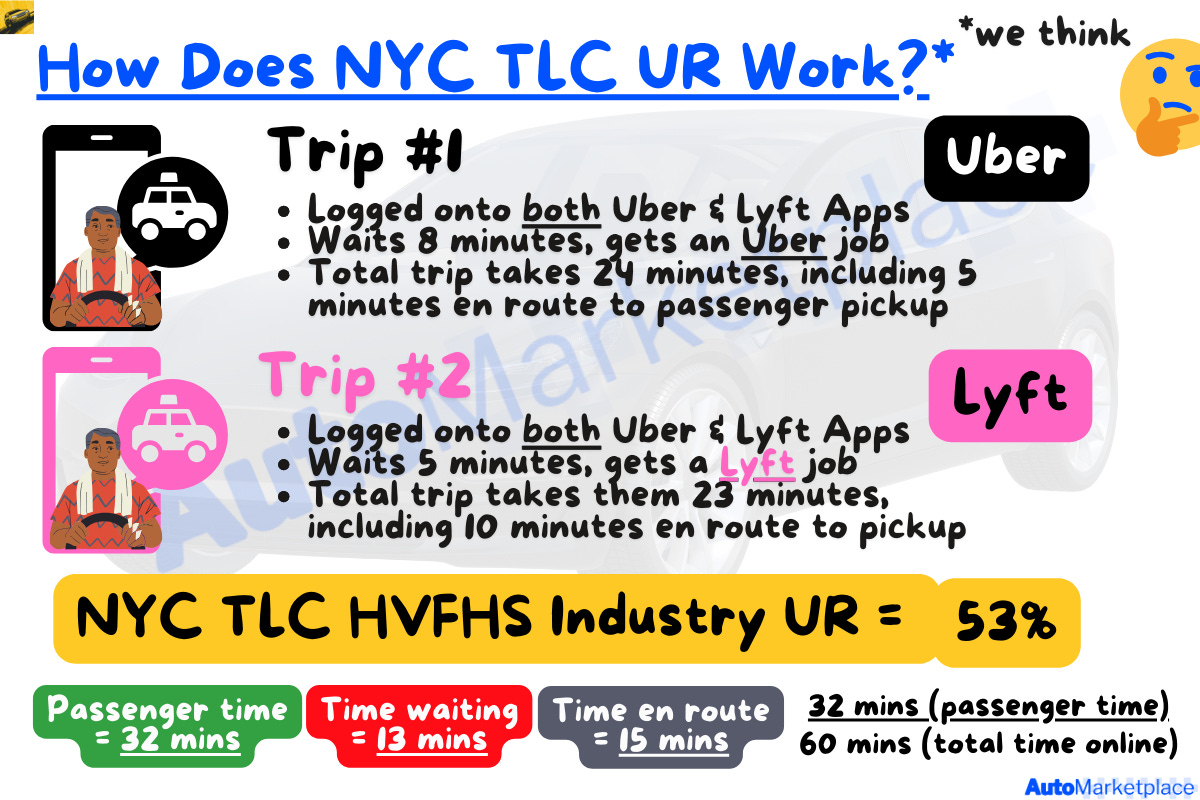
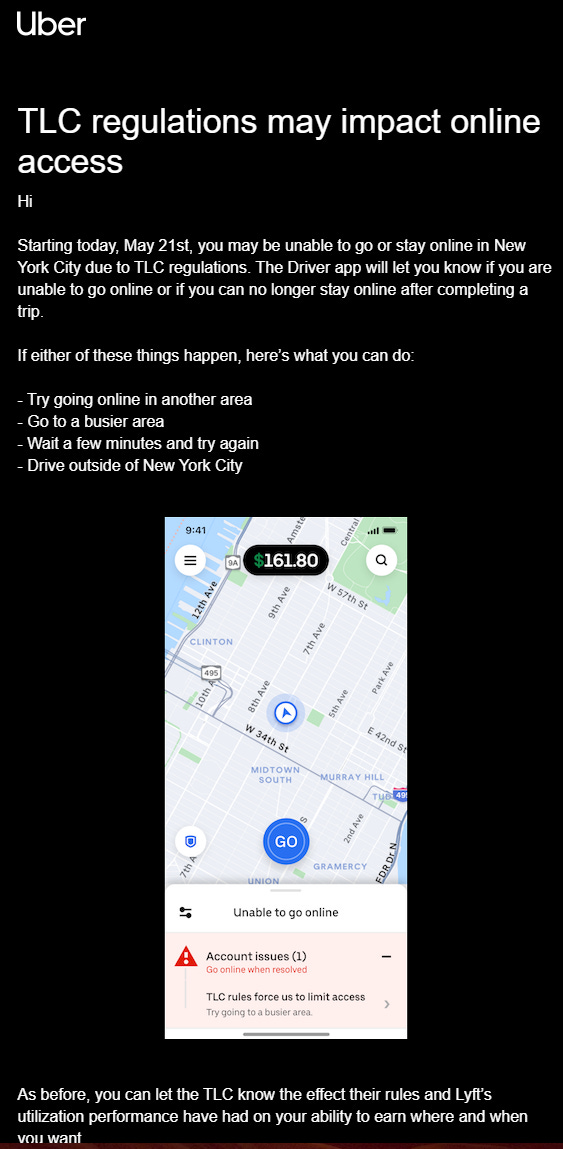

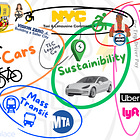
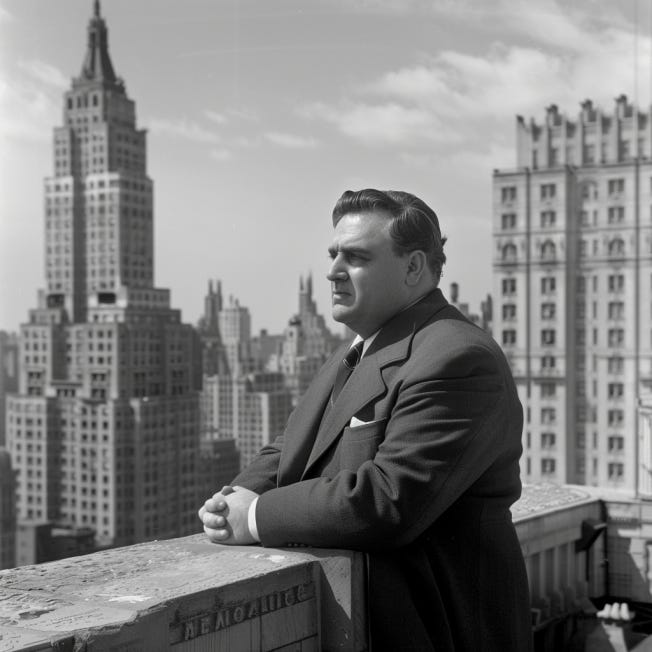
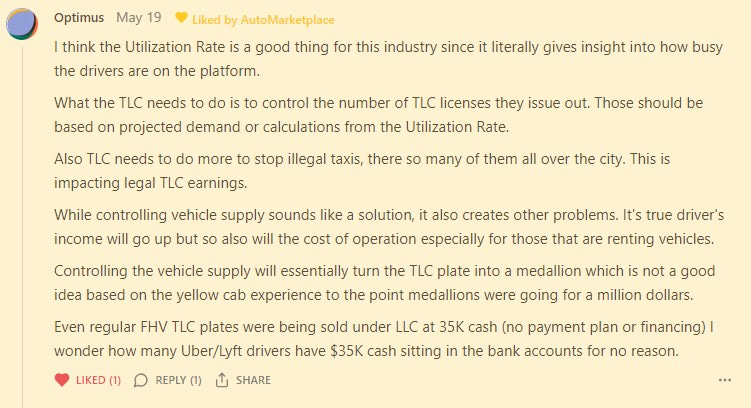





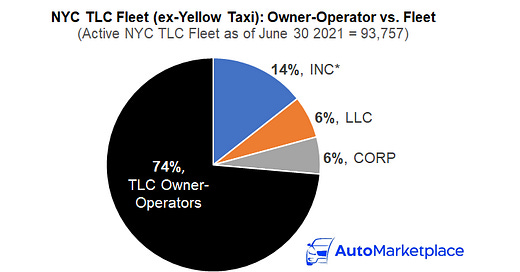

so much drama with this minimum wage job...
Illegal taxis that TLC seems to have no control over. Flooding the driver supply market with EV new cars this past autumn. Having brokers (basically what Uber and Lyft are) that we pay lessen our earnings through lockouts because of some convoluted system using a utility rate that is academically impressive but, in practice, a disaster because the brokers manipulate it to their benefit. We’re basically back to the age of pre-medallion but this time legitimate FHV drivers pay a government body, the TLC, for the “privilege.”
We do not need utility rates. The TLC is data-rich with information about exactly how long we are on each app, how much we earn on each ride, how many minutes we spend waiting for rides during what day and time, how much time we spend getting to rides. Theoretically, The TLC can mine all that data and make the proper adjustments (issuance of more/less vehicle and driver licenses) so that drivers can have a fair wage. Disruptions to driver pay becomes a problem in practice when the TLC becomes swayed by outside forces to act against the interests of drivers. Whether that is diving into an environmental policy that has not been studied well, succumbing to a City Hall that is favoring a certain corporation it has a very cozy relationship with (which shall remain nameless but you see their blue cars everywhere), instituting a new choking toll because a quasi-government agency can’t seem to manage its own finances, or the City Council considering legislation to lower the NYC speed limit from 25 to 20 MPH, legitimately licensed FHV drivers are paying the price. Everyone (TLC, the rideshare companies, City Hall, City Council, the riding public) dumps on the drivers yet we’re the ones who contribute the financial and sweat equity investments to enter and remain in this industry. When you take into consideration most drivers are immigrants, there is even less appeal for anyone to watch out for their interests. Unionizing and becoming a political force would be great but independent drivers are, well, fiercely independent and march to the best of their own drum, quite frankly.
Let’s be honest. In an age of vehicle robots and AI, this is the beginning of a now eventual death of the chauffeur driver as we know him/her. Although that progression towards automation is slow now it will eventually become more rapid but all the signs are sprouting around us. Soon the talk will be about how “safe” robot cars are and why would you want a distracted human driver. Driving is no longer a long-term career. If you’re young and you planned to drive to retirement, choose another career. You will be replaced by a machine. I know this sounds ominous but I’m sure there was a milkman or two out there who once wrote an essay about their dying industry.